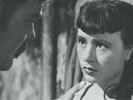Eye For Film >> Movies >> Sawdust And Tinsel (1953) Film Review
Circuses didn't always have the connotations they do now, a hangover of all the worst elements that gave them such voyeuristic appeal, of making freaks into 'freaks', and the inhumane treatment of animals that's not-really-on-now-any-more-is-it? Circuses, even the clowns that performed in the ring, were poetic, with universal appeal - everyone went. Somewhere along the line, teeth fell out and that changed, and it's this descent into trashy sideshow that forms Ingmar Bergman's background for a dark love story, whose horror lies in the realistic take on relationships it depicts.
The film opens with a travelling circus, and a flashback. The wife (Gudrun Brost) of Frost the clown (Anders Ek), loving but innocent in a way so corruptible, leaves the caravan to enjoy the beach, and the attention of an army platoon on R&R. Finding her enjoying herself with the men, Frost is destroyed. Carrying her back naked and almost silhouetted across the bare land, the pair make a sight as haunting as the deathly procession at the end of Bergman's most famous film, The Seventh Seal. Tragic is the clown made himself to look the fool.

In the present, the circus arrives at a rural town - by coincidence where the ring master's wife and children live, who he walked out on years before. His mistress Anne (Harriet Andersson) is apprehensive of what might happen should they be reunited. Their love is stronger, if it is love, for there's an edginess, a tension to their relationship throughout. The master, Albert (Played with brilliant bearish nature by Åke Grönberg) sees in this an opporunity to rejuvenate the circus, and make it a grand night out. But in order to put on a spectacle, they turn to the theatre troupe for costumes - and an actor mesmerised by Anne's charm.
There's an impressive symmetry to the whole piece; love and art, both are firmly grounded in reality. Despite his highbrow reputation, Bergman holds no ideals. Beautifully, he draws out the similarities between the art forms in the pomposity of one, the meekness of the other, as the circus folk beg for costumes from the touring theatre group. Although the director humiliates them, he admits he doesn't know why: after all, they're both seeking business in the same backwater town. The pretensions of either vocation are as swollen as the ringmaster Albert's belly. The title sums up this equal idea of art: Sawdust and Tinsel, circus and theatre, and men from both sides wrestle and scrap on the floor over a woman by the end of the film.
The idea of love in Sawdust fits much more within Bergman's common themes than that of The Devil's Eye. Relationships aren't blissful despite or because of infidelities; they're torn apart by (perhaps inevitable) betrayal and only ever partially mended. And yet we still try, as the cast do, making unwitting clowns out of themselves in the process. These themes combined in Sawdust make a beautiful statement, and an inetersting epitaph for Bergman. He wasn't pompous and pretentious like those who tried to imitate him; he was humble because he thought love didn't work, and one art form was no more important than another.
The dark shadows of Sven Nykvist's cinematography only deepen the horror, and the superb editing - particularly the silent shouts of Frost as he catches his wife with the regiment - creates an almost nightmarish effect in parts. Love tormented, realistic: it's a concept you can see in Bergman's work right to his last film, Saraband, where the estranged elderly couple lie in bed, naked and incontinent, and the one you suspect, despite his last happy marriage, he'd like his films to be remembered for.
Reviewed on: 17 Sep 2007


















